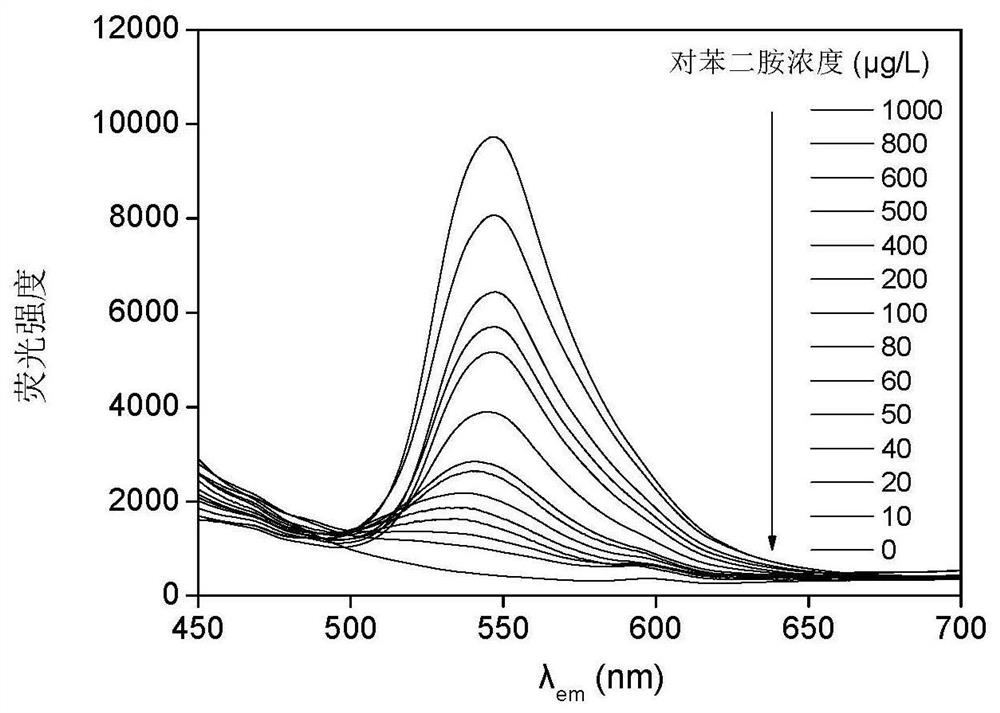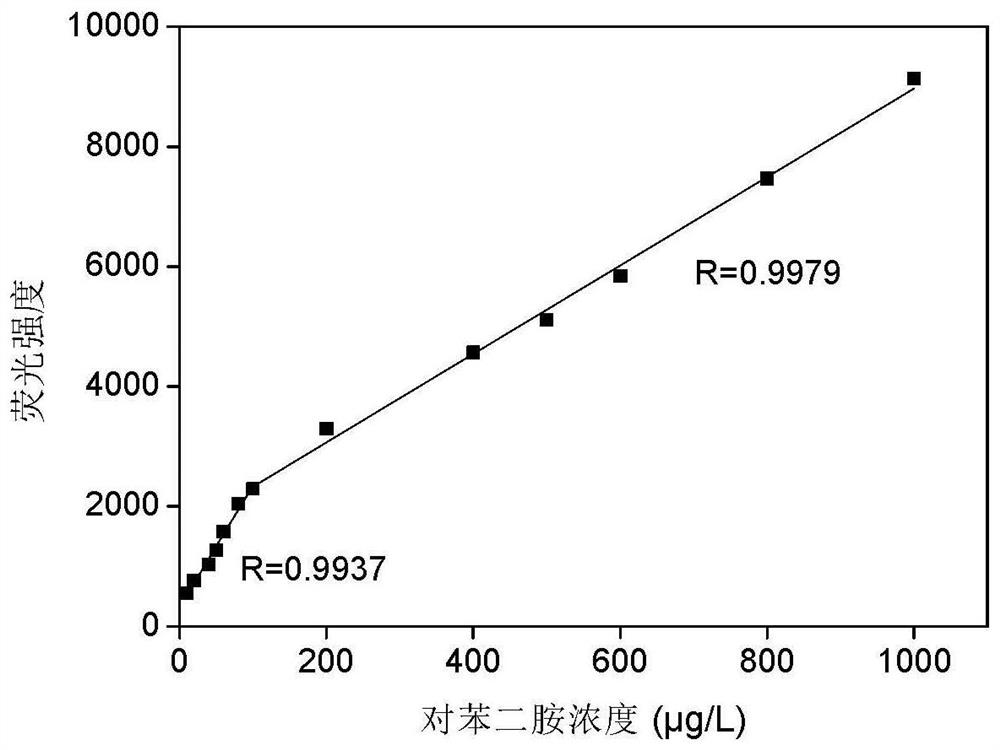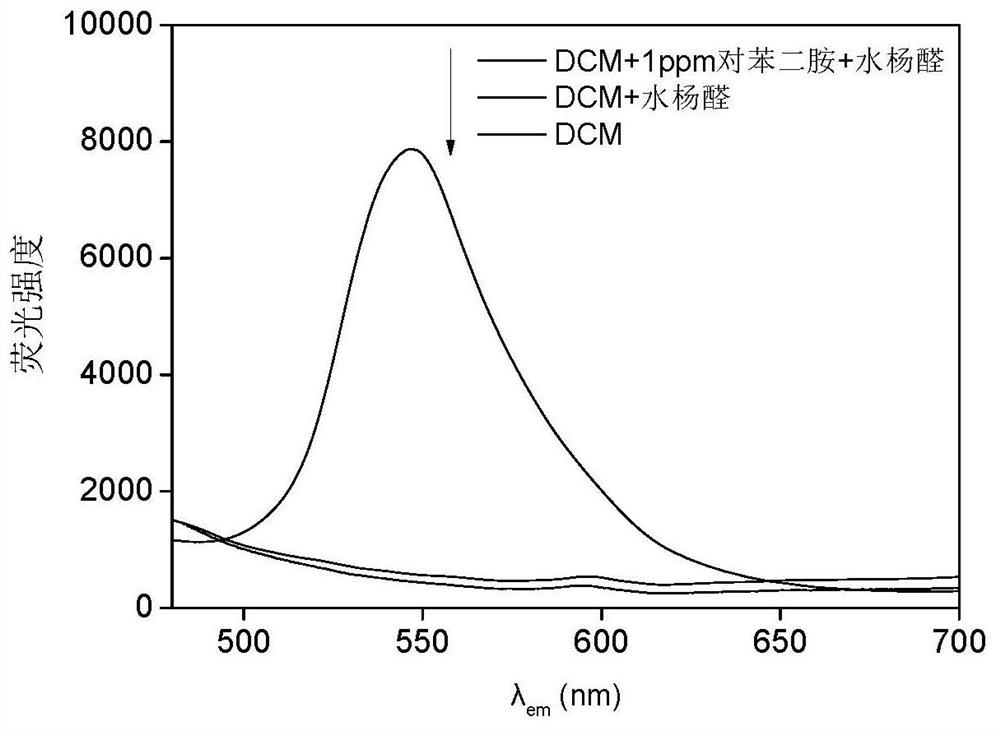A fast and efficient method for detecting trace p-phenylenediamine
A high-efficiency technology for p-phenylenediamine, applied in the field of analysis and detection of p-phenylenediamine, can solve the problems of high detection limit, inability to obtain, enhanced aggregation fluorescence, etc., and achieves high mechanical strength, easy chemical modification, and high optical transparency. Effect
- Summary
- Abstract
- Description
- Claims
- Application Information
AI Technical Summary
Problems solved by technology
Method used
Image
Examples
Embodiment 1
[0038] Example 1 Effect of phenylenediamine concentration on fluorescence intensity of solid phase fluorescence
[0039] A method of detecting phenylenediamine, a base is, including the following steps:
[0040] Step 1: The cellulose solution of cotton cellulose is prepared from 5% mass concentration;
[0041] Step 2: After depulating the cellulose solution obtained by step 1, the substrate flow is derived into a film, and the regenerative cellulose gel film is obtained after solidification;
[0042] Step 3: Putting the regenerated cellulose gel film obtained by step 2 into a 1 g / L of the sodium serotonate solution at room temperature for 6 h, resulting in an aldehydecellulose gel film;
[0043]Step 4: Place the dialdehyde fibers obtained in (3) in different concentrations of phenylenediamine (0, 10, 20, 40, 50, 60, 80, 100, 200, 400, 500, 600, 800) , 1000 μg / L) reaction, to obtain a cellulose film enriched to benzylamine;
[0044] Step 5: Immersing the cellulose membrane of t...
Embodiment 2
[0046] Example 2 Effect of salicyldehyde concentration on fluorescence intensity of solid phase fluorescence
[0047] The concentration of the phenylenediamine solution was 250 μg / L, and the effect of hydrosarian concentration on the fluorescence intensity of solid phase fluorescence was detected. Specific operation: The same diehydecellulosic membrane is placed in a 6 group 250 μg / L in a phenylenediamine solution, and the washed washed after a water bath at a water bath at 25 ° C. The film was then placed in a concentration of 0%, 0.01%, 0.05%, 0.1%, 0.5%, and 1% of the hydrarseofaldehyde solution, washed, and dried in a 50 ° C oven, and then tested each system in 370 nm excitation. Fluorescence spectrum under wavelength. The results show that as the concentration of hydrosalyceal is increased, the fluorescence intensity of the solid phase fluorescence detection film will be slowed down.
Embodiment 3
[0048] Example 3 Effect of oxide aldehyde group concentration on fluorescence intensity of solid phase fluorescence
[0049] Differential aldehyde cellulosic membranes differ from aldehyde content (0, 50, 200, 200, 300, 400 μmol / g) by changing the concentration of sodium the sodium diodate. Thereafter, the resulting dialdehyde film was placed in a p-phenylenediamine solution having a concentration of 250 μg / L, respectively, after 1 h, respectively, after 1 h, washed 1 h, respectively, washed at 25 ° C. The membrane of the enriched phenylenediamine was then placed in a hydrogen solution of 0.5%, washed 10 min, washed, and dried in a 50 ° C oven, and then tested fluorescence spectrum of each system at 370 nm excited wavelength. The results showed that the higher the aldehyde basal amount of diehyde cellulose, the greater the fluorescence intensity of the solid phase fluorescence detection film.
PUM
| Property | Measurement | Unit |
|---|---|---|
| emission peak | aaaaa | aaaaa |
| concentration | aaaaa | aaaaa |
| strength | aaaaa | aaaaa |
Abstract
Description
Claims
Application Information
 Login to View More
Login to View More - R&D
- Intellectual Property
- Life Sciences
- Materials
- Tech Scout
- Unparalleled Data Quality
- Higher Quality Content
- 60% Fewer Hallucinations
Browse by: Latest US Patents, China's latest patents, Technical Efficacy Thesaurus, Application Domain, Technology Topic, Popular Technical Reports.
© 2025 PatSnap. All rights reserved.Legal|Privacy policy|Modern Slavery Act Transparency Statement|Sitemap|About US| Contact US: help@patsnap.com



